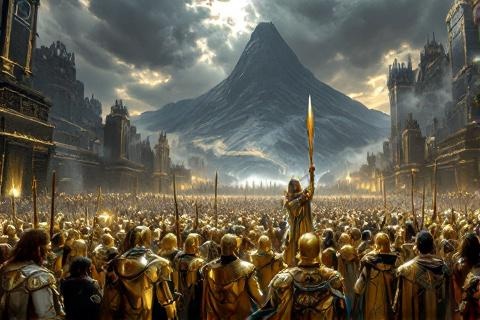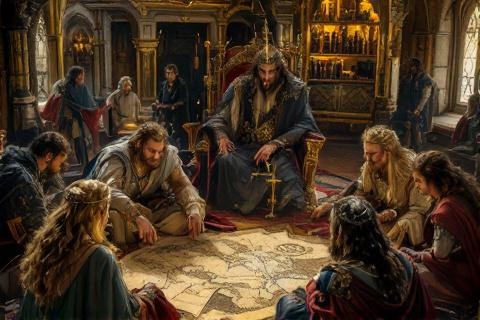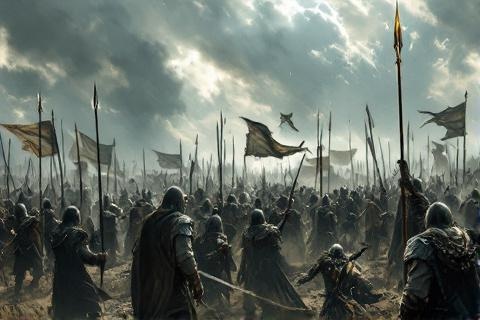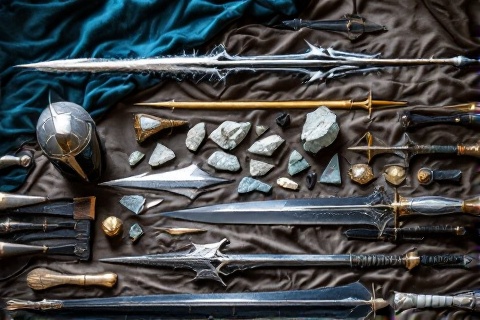
The Last Alliance of Elves and Men
The Final Stand Against Sauron
Origins of the Alliance

In the latter years of the Second Age, after forging the One
Ring in the fires of Mount Doom,
Sauron's power grew exponentially throughout
Middle-earth. From his fortress in
Mordor, he extended his influence across vast territories,
corrupting men and subjugating various peoples under his dominion while waging
war against the Elves of Eregion.
The fall of Númenor marked a crucial turning point in the
history of Middle-earth. The faithful Númenóreans, led by
Elendil and his sons, escaped the catastrophe and established the realms of
Arnor and Gondor in Middle-earth. These
kingdoms of the Dúnedain became strongholds of resistance against the growing
darkness.
High King Gil-galad in Lindon and Elendil in his newly
established realms recognized that Sauron posed an existential threat to all
free peoples of Middle-earth. Their wisdom and foresight led them to understand
that only through a united front could they hope to challenge the Dark Lord's
growing power. This recognition formed the foundation of what would become known
as the Last Alliance of Elves and Men.
The Gathering of Forces
The Elven armies assembled under Gil-galad's banner represented the greatest
gathering of Elven military might since the First Age. From
the havens of Lindon and the hidden valley of Rivendell, the Noldorin Elves
marched forth in their thousands, their spears gleaming and their armor shining
with an ancient glory not seen since the days of Beleriand.
The armies of the Númenóreans in exile proved equally impressive, as both the
northern kingdom of Arnor and the southern realm of Gondor contributed their
full military strength. These forces represented the pinnacle of human martial
prowess, combining the ancient wisdom of Númenor with the strength and nobility
of their bloodline.
The Dwarves of Khazad-dûm, though not
fully committed to the primary force, joined the Alliance as auxiliary troops.
Under the leadership of their king Durin IV, they provided crucial support with
their superior weaponry and their knowledge of warfare in mountainous terrain.
Their participation, while limited, demonstrated the gravity of the threat
Sauron posed to all free peoples.
Leaders of the Alliance

Gil-galad, the last High King of the Noldor in Middle-earth, led
the Alliance wielding his legendary spear Aeglos. His presence on the
battlefield inspired both Elves and Men alike, as he represented the last
vestiges of the glory of the First Age. The spear Aeglos was said to glow with a
deadly frost that no enemy could withstand.
Elendil the Tall, standing over seven feet in height, wielded the mighty sword
Narsil, forged by the Dwarf-smith Telchar in the First Age.
His commanding presence and tactical acumen made him a natural co-leader of the
Alliance, earning him respect from both the Eldar and the Edain
alike.
Isildur and Anárion, the sons of Elendil, proved themselves worthy of their
father's legacy. While Isildur commanded the forces of Arnor, Anárion led the
armies of Gondor, both demonstrating the strength and nobility of their
Númenórean heritage. Their combined military expertise significantly contributed
to the Alliance's strategic advantages.
Elrond, serving as Gil-galad's herald, brought his considerable experience and
wisdom to the Alliance. Having witnessed the events of both the First and Second
Ages, his counsel proved invaluable in both strategic planning and maintaining
unity among the diverse forces. His role as herald placed him at the center of
diplomatic relations between the various peoples of the Alliance.
The March to Mordor
The crossing of the Misty Mountains represented one of the greatest logistical
challenges faced by the Alliance. The massive army had to navigate treacherous
passes and harsh weather conditions while maintaining their combat readiness.
This feat of military organization demonstrated the exceptional planning
capabilities of the Alliance's leadership.
As the combined forces moved through the vales of Anduin, they established
supply lines and secured their route against potential enemies. The great river
served as both a highway for their supplies and a strategic barrier against
Sauron's forces, allowing the Alliance to maintain its strength as it moved
southward.
During their march, the Alliance gathered additional supporters from various
settlements and peoples along their path. These included settlements of Men in
the Vales of Anduin, remnants of the Elven populations that had not yet departed
Middle-earth, and other free peoples who recognized the crucial nature of this
campaign against Sauron.
The Siege of Barad-dûr

The siege of Barad-dûr lasted seven years, during which the Alliance maintained
a strict encirclement of Sauron's fortress. This prolonged campaign tested the
endurance and resolve of both Elves and Men, requiring unprecedented cooperation
and resource management to maintain their position against the Dark Lord's
forces.
The Alliance constructed elaborate siege works and fortifications around Mordor,
establishing a network of defensive positions and supply depots. These
engineering feats, combining Númenórean technology with Elven craft, created an
impenetrable barrier that prevented Sauron's forces from breaking out or
receiving reinforcements.
Throughout the siege, Sauron's forces launched numerous sorties and
counter-attacks against the Alliance's positions. Each assault was met with
fierce resistance, as the combined arms of Elves and Men proved superior to the
Dark Lord's armies of Orcs and corrupted Men. The Alliance's
defensive strategy gradually wore down Sauron's military strength.
The Battle of Dagorlad

The decisive battle on the plains before Mordor marked the culmination of years
of strategic planning and military preparation. The Alliance's forces
demonstrated their superior tactics and coordination, with the Elven archers and
Númenórean infantry working in perfect harmony to counter Sauron's armies.
The breaking of Sauron's armies came after intense fighting, as the combined
might of the Alliance proved too strong for even his seemingly endless hordes.
The disciplined ranks of the Númenóreans, supported by the swift and deadly
Elven warriors, systematically destroyed the enemy's military cohesion.
The Silvan Elves, fighting alongside their Noldorin kin, suffered particularly
heavy losses during the battle. Their sacrifice demonstrated the dedication of
all Elven peoples to the cause of defeating Sauron, regardless of their realm or
lineage.
The victory on the plains opened the way into Mordor itself, allowing the
Alliance to press their advantage toward Barad-dûr. This success proved that
Sauron was not invincible and that the combined strength of Elves and Men could
overcome even the greatest evils of Middle-earth.
The Final Confrontation

Sauron's personal emergence from Barad-dûr marked a desperate turn in the
battle, as the Dark Lord himself came forth to face his enemies. His presence on
the battlefield brought terror to even the bravest warriors, yet the leaders of
the Alliance stood firm against his onslaught.
The death of Gil-galad came at the hands of Sauron himself, as the High King was
consumed by the Dark Lord's burning touch. The loss of the last High King of the
Noldor marked the end of an age and dealt a grievous blow to the Elven peoples
of Middle-earth.
Elendil fell in combat against Sauron, and his mighty sword Narsil shattered
beneath him. The death of the High King of the Númenóreans in exile represented
a crucial moment in the history of Men, marking both an end and a beginning for
their peoples.
In a moment that would shape the future of Middle-earth, Isildur took up his
father's broken sword and cut the One Ring from Sauron's hand. This act brought
about Sauron's defeat and the collapse of his physical form, though his spirit
would endure due to the Ring's continued existence.
Aftermath and Consequences
Following the victory, the kingdoms of Arnor and Gondor were formally
established as the chief realms of Men in Middle-earth. Under the leadership of
Isildur and the heirs of Anárion, these kingdoms would become the guardians of
wisdom and civilization in the coming age.
The defeat of Sauron marked the end of the Second Age and the beginning of the
Third. This new era would see the gradual decline of Elven influence in
Middle-earth and the rise of the dominion of Men.
Isildur's decision to keep the One Ring, despite counsel to destroy it, would
have far-reaching consequences. Rather than cast it into the fires of Mount Doom
where it was forged, he claimed it as weregild for his father's death and his
brother's loss.
Elrond established Rivendell as a sanctuary of lore and wisdom, preserving the
knowledge and culture of the Eldar in Middle-earth. This haven would serve as a
crucial center of resistance against evil in the ages to come, maintaining the
memory of the Last Alliance and its significance.
Weapons and Artifacts

Gil-galad's spear Aeglos was renowned for its deadly effectiveness against the
forces of darkness. The weapon's name, meaning 'Snow-point' in Sindarin,
reflected its frost-like properties in battle. The fate of this legendary weapon
after Gil-galad's fall remains unknown.
The sword Narsil, though broken in the final battle, remained a symbol of hope
and resistance against evil. Forged by Telchar of Nogrod in the First Age, its
shards would later be reforged as Andúril, the Flame of the
West.
The One Ring, cut from Sauron's hand by Isildur, remained the central artifact
of power throughout the following ages. Its preservation, rather than
destruction, ensured that Sauron's spirit would endure and eventually regain
strength.
The armies of the Last Alliance bore distinctive armor and banners that
reflected their respective cultures. The Elven forces carried the
star-emblazoned banners of Gil-galad, while the Men of Númenor marched under the
symbols of the White Tree and the Seven Stars.
Historical Impact
The defeat of Sauron marked the definitive end of his dominion in the Second
Age, concluding an era of darkness that had threatened to engulf all of
Middle-earth. His defeat demonstrated that even the mightiest of evils could be
overcome through unity and sacrifice.
The victory of the Last Alliance came at a great cost to the Elven realms, as
their strength was significantly diminished by the losses suffered in the war.
This weakening accelerated the gradual fading of the Elves from Middle-earth, a
process that would continue throughout the Third Age.
The beginning of the dominion of Men was marked by both triumph and uncertainty.
While the Númenórean kingdoms reached their height of power, the preservation of
the One Ring ensured that their victory remained incomplete.
The decision to preserve rather than destroy the One Ring would eventually lead
to centuries of conflict and strife. This choice would necessitate the formation
of another great alliance in the Third Age, echoing the struggles of their
ancestors against the same ancient evil.
